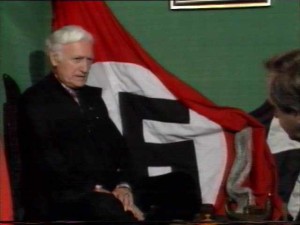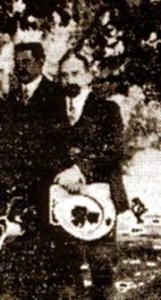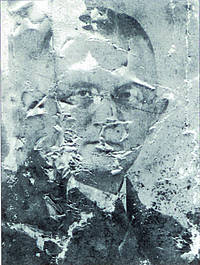Rafael Videla Eissmann
Eissmann, Rafael Videla
Rafael Videla Eissmann is a Chilean historian and lecturer(a). He has published two books (in Spanish) on Atlantis[799][800] based on conversations with the Chilean nazi Miguel Serrano. The theories of Hanns Hörbiger are investigated and supported. Eissmann has also lectured on Hörbiger and other heroes and supporters of the Third Reich such as Edmund Kiss.
Hanns Hörbiger are investigated and supported. Eissmann has also lectured on Hörbiger and other heroes and supporters of the Third Reich such as Edmund Kiss.
Eissmann’s most important contribution to Atlantean studies was arguably his resurrection[792] of the work of Robert Rengifo(c)* who along with Arthur Posnansky were possibly the first people to suggest Antarctica as the location of Atlantis.
In 2021, Eissmann published a Bibliography in Spanish of the Works of James Churchward.(b)
(a) https://www.obrasrafaelvidelaeissmann.blogspot.com/
Serrano, Miguel
Miguel Serrano (1917-2009) was a former Chilean diplomat in which capacity he was  appointed ambassador to India from 1953 until 1962. He was also an unrepentant nazi sympathiser since 1939 and over time he developed what became known Esoteric Nazism, which continues to have support particularly in his native Chile, where there are still substantial numbers of Nazi followers(a).
appointed ambassador to India from 1953 until 1962. He was also an unrepentant nazi sympathiser since 1939 and over time he developed what became known Esoteric Nazism, which continues to have support particularly in his native Chile, where there are still substantial numbers of Nazi followers(a).
*Joscelyn Godwin relates[789.126] how Serrano claimed that “the Germans also found there was a way of communication with the Hollow Earth and its secret cities, where the First Hyperboreans had taken refuge from the disaster that reversed the Poles. There a secret base was prepared during the war years, and thither Adolf Hitler escaped in a vimana (flying saucer plane) to direct the “esoteric war” to this day.”*
The spitfirelist website notes that when “Serrano returned to Chile after the Pinochet coup in 1973. Finding the regime unsympathetic to his ideas, he adopted “the role of intellectual gadfly“.[9] In May 1984, Serrano gave the Nazi salute at the funeral in Santiago of SS Colonel Walter Rauff.[9] He convened a rally in Santiago on 5 September 1993, in honor of Rudolf Hess, and in memory of the 62 young Chilean Nazi supporters who were shot dead while occupying a social security building during an abortive coup in 1938.[1][10] “(c)
Two books by the Chilean historian, Rafael Videla Eissmann, are concerned with Serrano’s views on Atlantis. Many of his other works, mainly in Spanish, are available as pdf files(b).
(a) https://www.pbs.org/frontlineworld/fellows/chile_2008/
(b) https://www.pdfarchive.info/index.php?pages/Se
(c) https://spitfirelist.com/for-the-record/ftr-873-the-new-age-fascism-and-the-atlantis-myth/
Rengifo, Robert
Robert Rengifo was a little known Chilean professor who flourished in the early decades of the 20th century. He had an intense interest in the prehistory of America and presented  his views in the Proceedings of the prestigious Societe Scientifique du Chili(The Scientific Society of Chile) from 1904 until 1935. He focused on the aboriginal peoples of Chile and in particular Patagonia in the extreme south. His attention was drawn even further south to Antarctica where he controversially concluded that man had originated (rather than Africa). Then following a catastrophic axial pole shift that destroyed Atlantis, which was located in Antarctica, people were forced to migrate, populating the rest of the Americas and then the world.
his views in the Proceedings of the prestigious Societe Scientifique du Chili(The Scientific Society of Chile) from 1904 until 1935. He focused on the aboriginal peoples of Chile and in particular Patagonia in the extreme south. His attention was drawn even further south to Antarctica where he controversially concluded that man had originated (rather than Africa). Then following a catastrophic axial pole shift that destroyed Atlantis, which was located in Antarctica, people were forced to migrate, populating the rest of the Americas and then the world.
Rafael Videla Eissmann, who has championed Rengifo’s work has drawn attention to an excerpt from the epic poem, La Araucana, by Alonso de Ercilla y Zúñiga (1533-1594) which translates from the original Castilian as
“Chile, fertile and known land
in the famous Antarctic region
from ancient nations respected
because of being strong, important and powerful”.
Eissmann believes that this suggests knowledge of an ancient Antarctic polar civilisation!
While many of his conclusions may now appear purely speculative, in fact, Rengifo thought his views would eventually be vindicated by archaeology. The Monte Verde site in southern Chile has since been dated to around 11,000 BC. In addition, the enormous dressed stone blocks of El Enladrillado, also in Chile, raise questions about the technological capabilities of the region’s early inhabitants.
This apparent movement of peoples from south to north was endorsed by Arthur Posnansky in his 1919 book La Hora Futura [0941] The ensuing half century saw more of his conclusions echoed by researchers such as Charles Hapgood, the Flem-Aths, Hugh Auchincloss Brown and Robert Argod.
His work has recently been highlighted in a 2008 book[792] by Rafael Videla Eissmann as well as in a series of papers on his website(a). Another overview of Rengifo’s theories is available online(b).
(a) https://obrasrafaelvidelaeissmann.blogspot.com/ (Spanish) [use search facility]
*(b) https://web.archive.org/web/20160326042154/https://www.alertaaustral.cl/articulo.php?id=190*
Kiss, Edmund
Edmund Kiss (1886-1960) was a German architectural student with an interest in archaeology. After the First World War, he wrote a number of adventure novels. In the 1920’s he began his foray into the world of ‘alternative archaeology. Later in that decade, he made his first visit to Tiahuanaco.
During this period Kiss worked with Arthur Posnansky and advanced the idea that Tiahuanaco had been built by Nordic refugees from Atlantis (Thule) more than 17,000 years ago. Their work included a search for evidence to support the theories of Hanns Hörbiger.
Matthew Gildner, a professor of Latin American history has written an interesting essay on the background to Kiss’ theories and work in Bolivia(b).
During the Third Reich Kiss was requested by Heinrich Himmler to take a team of researchers from the Ahnenerbe to continue his studies at Tiahuanaco but the expedition was called off. Following that he briefly joined the Waffen SS. After the war he continued his interest in Atlantis, writing a book on Plato’s Critias and contributing to Egerton Sykes’ Atlantean Research newsletter in the 1950s.
Rafael Videla Eissmann is a historian at the Catholic University of Chile and has written a number of articles in Spanish(a) regarding Kiss, as well as a wide range of other historical subjects.
>Dr. Graham Horton has written about the pseudo-science of Kiss and Posnansky in the early 20th century relating to their work at Tiwanaku(d).<
As late as 1953, Kiss was still defending Hörbiger’s idea of an ice-covered Moon>as was Egerton Sykes(c). Further related articles were available on the now defunct geocities website(e).<
(a) https://charlasylecturas.blogspot.com/
(b) https://theappendix.net/issues/2013/4/andean-atlantis-race-science-and-the-nazi-occult-in-bolivia
(c) Atlantis, Volume 6, No.1, May 1953
(e) titicaca (archive.org) *

